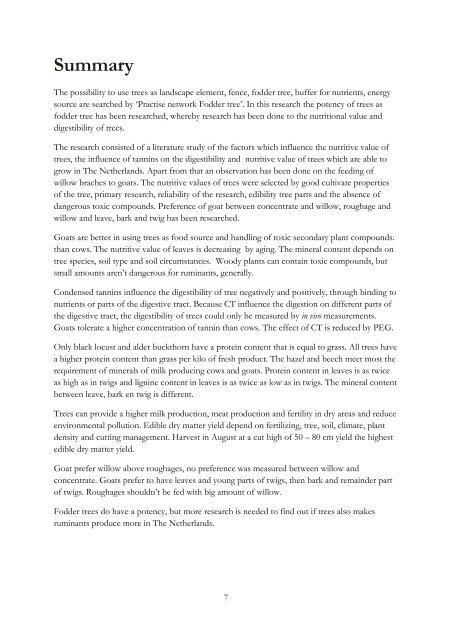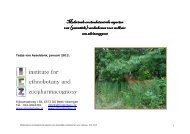Voederbomen: een verrijking voor het rantsoen? - Praktijknetwerk ...
Voederbomen: een verrijking voor het rantsoen? - Praktijknetwerk ...
Voederbomen: een verrijking voor het rantsoen? - Praktijknetwerk ...
You also want an ePaper? Increase the reach of your titles
YUMPU automatically turns print PDFs into web optimized ePapers that Google loves.
Summary<br />
The possibility to use trees as landscape element, fence, fodder tree, buffer for nutrients, energy<br />
source are searched by ‘Practise network Fodder tree’. In this research the potency of trees as<br />
fodder tree has b<strong>een</strong> researched, whereby research has b<strong>een</strong> done to the nutritional value and<br />
digestibility of trees.<br />
The research consisted of a literature study of the factors which influence the nutritive value of<br />
trees, the influence of tannins on the digestibility and nutritive value of trees which are able to<br />
grow in The Netherlands. Apart from that an observation has b<strong>een</strong> done on the feeding of<br />
willow braches to goats. The nutritive values of trees were selected by good cultivate properties<br />
of the tree, primary research, reliability of the research, edibility tree parts and the absence of<br />
dangerous toxic compounds. Preference of goat betw<strong>een</strong> concentrate and willow, roughage and<br />
willow and leave, bark and twig has b<strong>een</strong> researched.<br />
Goats are better in using trees as food source and handling of toxic secondary plant compounds.<br />
than cows. The nutritive value of leaves is decreasing by aging. The mineral content depends on<br />
tree species, soil type and soil circumstances. Woody plants can contain toxic compounds, but<br />
small amounts aren’t dangerous for ruminants, generally.<br />
Condensed tannins influence the digestibility of tree negatively and positively, through binding to<br />
nutrients or parts of the digestive tract. Because CT influence the digestion on different parts of<br />
the digestive tract, the digestibility of trees could only be measured by in vivo measurements.<br />
Goats tolerate a higher concentration of tannin than cows. The effect of CT is reduced by PEG.<br />
Only black locust and alder buckthorn have a protein content that is equal to grass. All trees have<br />
a higher protein content than grass per kilo of fresh product. The hazel and beech meet most the<br />
requirement of minerals of milk producing cows and goats. Protein content in leaves is as twice<br />
as high as in twigs and lignine content in leaves is as twice as low as in twigs. The mineral content<br />
betw<strong>een</strong> leave, bark en twig is different.<br />
Trees can provide a higher milk production, meat production and fertility in dry areas and reduce<br />
environmental pollution. Edible dry matter yield depend on fertilizing, tree, soil, climate, plant<br />
density and cutting management. Harvest in August at a cut high of 50 – 80 cm yield the highest<br />
edible dry matter yield.<br />
Goat prefer willow above roughages, no preference was measured betw<strong>een</strong> willow and<br />
concentrate. Goats prefer to have leaves and young parts of twigs, then bark and remainder part<br />
of twigs. Roughages shouldn’t be fed with big amount of willow.<br />
Fodder trees do have a potency, but more research is needed to find out if trees also makes<br />
ruminants produce more in The Netherlands.<br />
7



